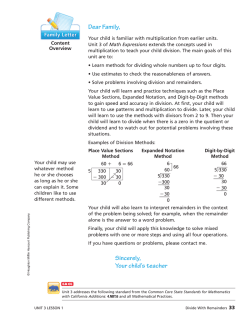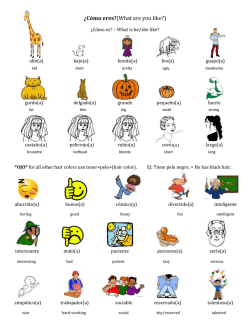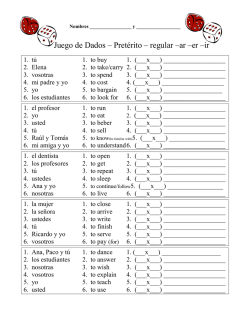
Nuestras cosas favoritas Capítulo 2
Capítulo 2 Nombre: Nuestras cosas favoritas La clase de tercer grado de la Srta. Díaz realiza encuestas para conocer sobre las cosas favoritas de los estudiantes. Registran los datos en tablas. Deportes favoritos Deporte Kickball Número 8 Fútbol 19 Baloncesto 12 2. Seis estudiantes más dicen que les gusta el kickball. ¿Cuántos estudiantes más prefieren fútbol que kickball ? Escribe enunciados numéricos para resolver el problema. 6 • Grado 3 • Capítulo 2 • Tarea de rendimiento © Houghton Mifflin Harcourt Publishing Company 1. Enrico reúne datos sobre deportes. Usa los datos para hacer una pictografía. Incluye una leyenda. Dibuja una gráfica en el siguiente espacio. 3. Tenley reúne datos sobre mascotas. Usa los datos para hacer una gráfica de barras. Incluye una escala. Dibuja la gráfica en el siguiente espacio. Mascotas favoritas Mascota Número Gato Perro Hámster Pájaro © Houghton Mifflin Harcourt Publishing Company 4. Tenley reúne más datos. Ahora 3 estudiantes más eligen los hámsteres. ¿Cuántos estudiantes menos prefieren los hámsteres que los perros? Escribe enunciados numéricos para resolver el problema. Grado 3 • Capítulo 2 • Tarea de rendimiento • 7 Chapter 2 Represent and Interpret Data Our Favorite Things COMMON CORE STANDARDS CC.3.MD.3Draw a scaled picture graph and a scaled bar graph to represent a data set with several categories. Solve one- and two-step “how many more” and “how many less” problems using information presented in scaled bar graphs. PURPOSE To assess the ability to represent and interpret data in picture and bar graphs TIME 25–30 minutes GROUPING Individuals MATERIALS • Performance Task, paper, pencil PREPARATION HINTS • Review gathering data by using tally marks. • Review recording data such as tally marks in a table. IMPLEMENTATION NOTES • R ead the task aloud to students and make sure that all students have a clear understanding of the task. • Students may use manipulatives to complete the task. • Allow students as much paper as they need to complete the task. • Allow as much time as students need to complete the task. • Students must complete the task individually, without collaboration. TASK SUMMARY Students read and interpret data in tables. They display data in tables by constructing a picture graph and a bar graph. Students then interpret the data in the graphs by solving word problems and writing number sentences. REPRESENTATION In this task teachers can… • Provide options for comprehension by activating prior knowledge about different ways to display and analyze data. • P rovide multiple means of representation by presenting concepts with physical models and manipulatives. 8 • Grade 3 • Chapter 2 • Performance Task © Houghton Mifflin Harcourt Publishing Company • Collect all student work when the task is complete. ACTION and EXPRESSION In this task teachers can… • Use multiple means of communication by allowing students to use computer design programs to create graphs. ENGAGEMENT In this task, teachers can… • Sustain effort and persistence by presenting concepts in the context of students’ homes, school, and neighborhood. • Help students meet goals and objectives by prompting them to restate the goal of this task. EXPECTED STUDENT OUTCOMES • Complete the task within the time allowed • Reflect engagement in a productive struggle • Represent and interpret data in picture and bar graphs SCORING © Houghton Mifflin Harcourt Publishing Company Use the associated Rubric to evaluate each student’s work. Grade 3 • Chapter 2 • Performance Task • 9 Performance Task Rubric OUR FAVORITE THINGS A level 4 response • Indicates that the student has made sense of the task and persevered • Accurately represents and interprets data in tables and graphs • Demonstrates an understanding of how graph keys and scales are constructed • Accurately applies graphing concepts when using graphs to solve problems A level 3 response • Indicates that the student has made sense of the task and persevered • Accurately represents and interprets data in tables and graphs • Demonstrates an understanding of how graph keys and scales are constructed • Accurately applies graphing concepts when using graphs to solve problems • Addresses most or all aspects of the task, but may make minor errors that can be corrected with revision A level 2 response • Shows that the student has made sense of at least some elements of the task • Shows evidence of understanding that data can be represented in picture or bar graphs • May not indicate a complete understanding of how to construct graphs or use graph keys and scales • Shows little evidence that the student has made sense of the problems of the task • Reflects a lack of understanding of interpreting data tables and constructing graphs • Shows little evidence of adequately addressing the elements of the task 10 • Grade 3 • Chapter 2 • Performance Task © Houghton Mifflin Harcourt Publishing Company A level 1 response Sample Level 4 Response Grade 3 • Chapter 2 • Performance Task • 10A Sample Level 3 Response 10B • Grade 3 • Chapter 2 • Performance Task Sample Level 2 Response Grade 3 • Chapter 2 • Performance Task • 10C Sample Level 1 Response 10D • Grade 3 • Chapter 2 • Performance Task
© Copyright 2025



